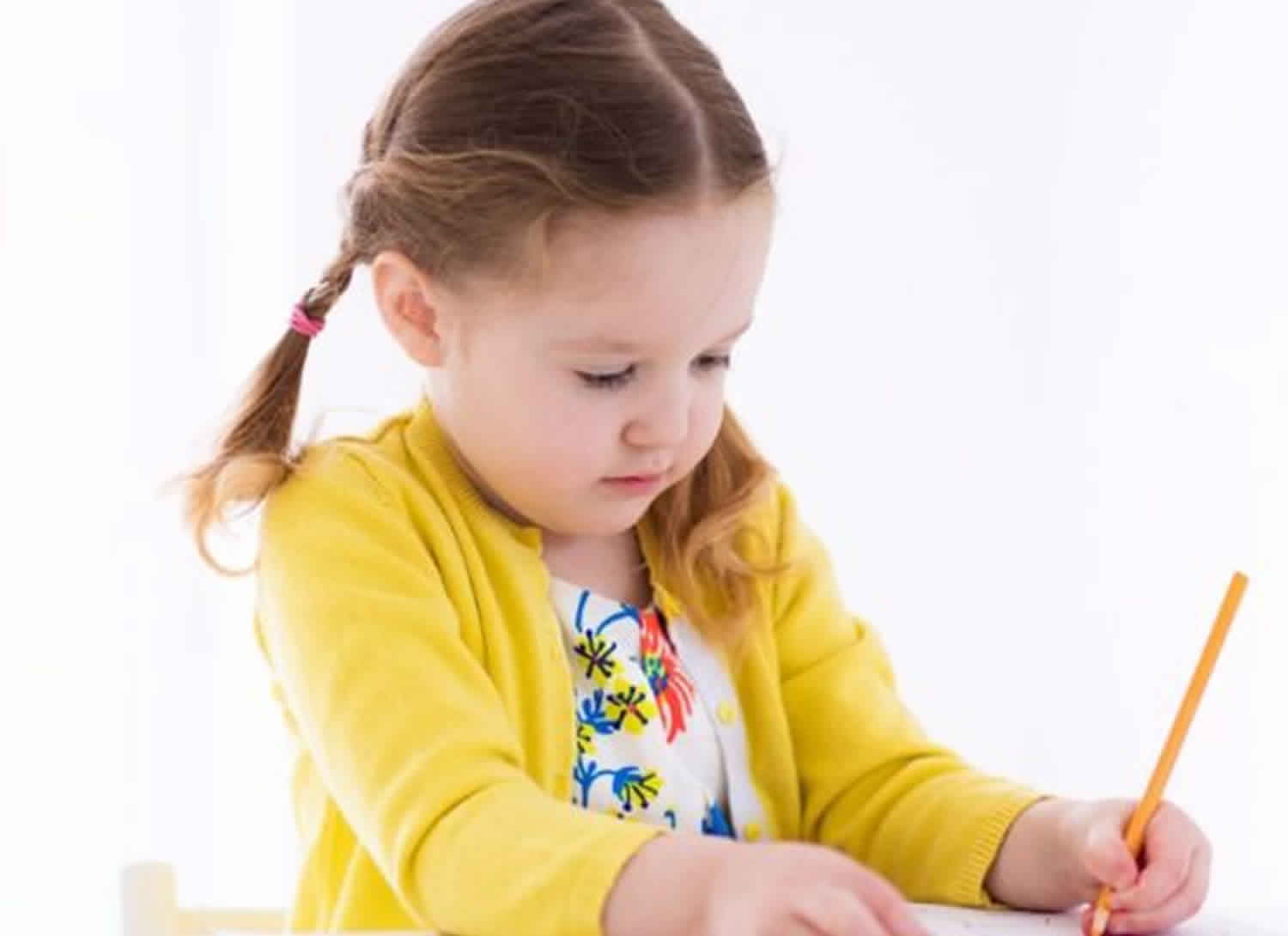How to teach a child to write
Even though many children and adults use computers, tablets and phones at home, school and work, handwriting is still an important part of literacy and an essential skill for life. For toddlers and preschoolers, handwriting is about drawing and scribbling with crayons and chalk. Older children learn formal handwriting at school.
Drawing and scribbling lay the foundations for handwriting. Handwriting starts with scribbling and drawing then moves on to forming letters and words.
You can encourage your child to develop an interest in handwriting by giving him opportunities to draw, scribble and write. This prepares him for the formal handwriting he’ll learn at school.
Writing is a complex process that requires a wide range of skills — a strong vocabulary; an understanding of genre, text structure, and voice; basic mechanical skills (grammar and punctuation); organizational skills; and higher order thinking.
Creative and pretend play can improve your child’s literacy. It also puts some of your child’s drawing skills into practice.
A child’s writing development parallels the child’s development as a reader. Part of early print awareness is the realization that writing can be created with everyday tools such as pens, pencils, crayons, and markers. Children begin to imitate the writing that they see in the environment. What often starts as scribbling ends up being important clues to a child’s understanding that print carries meaning. For example, children who can write smoothly and clearly are better able to use writing to record their thoughts and ideas. When handwriting is automatic, their ideas can flow. Children also need to write to do homework, tests and assignments.
You also need handwriting skills to do many tasks later in life like writing birthday cards, filling in forms and signing important documents.
As with reading skills, writing grows through explicit instruction. Writing is a skill with rules and structures. Across multiple grade levels, good writers are created through systematic, explicit instruction, combined with many opportunities to write and receive feedback.
Writing may be the most complex process that you expect your child to learn.
How children learn handwriting
Handwriting is a complex skill that develops over time. To learn handwriting children need to combine fine motor skills, language, memory and concentration. They also need to practise and follow instructions.
Handwriting starts with scribbling and drawing then moves on to forming letters and words.
You can encourage your child to develop an interest in handwriting by giving her opportunities to draw, scribble and write. This prepares young children for the formal handwriting they’ll learn at school.
Left-handed writing in children
Most children choose to write and draw with their right hands. But some children choose their left hands. This is OK. If your child chooses his left hand to write with, there’s no need to make him swap hands.
Children who write with their left hands might find it hard to see their writing because their left hands cover their writing as it moves across the page. By tilting your child’s page so that the left-hand corner is highest, you can help her more easily see what she’s writing or drawing.
What you need for drawing, scribbling and writing with your child
Set up your child at a table with some chunky crayons, pencils or markers, as well as some paper or card.
It’s best for your child to draw and write sitting at a table. The stable, flat surface can make it easier for your child to draw, and it also encourages your child to hold the crayon or pencil correctly.
How to do drawing, scribbling and writing activities with your child
Give your child lots of opportunities to draw and write. This helps your child develop the skills she needs for handwriting.
Here are some ideas:
- Have drawing materials handy so that your child can draw and scribble any time he feels like it. You can even take materials with you when you go out.
- Encourage your child to sit at a table to draw. You can put a cushion on your child’s chair so that her elbows are just above the height of the table. This makes it easier for her to hold the crayon or pencil.
- Let your child decide what to draw or write. Any practice he gets holding a crayon or pencil and drawing pictures, lines or circles helps him with learning to write.
- Talk with your child about her drawing or writing – for example, ‘Tell me about your picture’. Praise your child’s efforts, even if her ‘writing’ or ‘drawing’ is more like scribble – for example, ‘Well done! That looks like an ‘M’ and a ‘W’. Great writing’.
- Encourage your child to sign his work, even if it’s just the first letter of his name or a scribble. Then write his name underneath so he gets used to seeing it.
- Display your child’s work. For example, put it on the fridge and point it out to people who visit.
Adapting drawing, scribbling and writing activities for children of different ages
Make sure your younger child has thick chunky crayons to draw with until she’s developed the finger and thumb grip she needs to hold a thin pencil.
Help your older child to write words to go with a drawing. He might want to write a story or write people’s names underneath their pictures. If your child is just learning to write, you could also ask whether he wants to write a letter or help you write the shopping list.
How to teach toddler to write
Drawing is the start of handwriting for toddlers. Toddlers generally begin to show an interest in drawing with a crayon or chalk from about two years.
Here are a few ideas to get your toddler drawing, scribbling and ‘writing’:
- Have crayons and paper, or chalk and blackboard, handy. Small chunks of chalk or crayons encourage your child to use a fingertip grip. This helps him learn to hold a pencil.
- Encourage your child to draw things that interest her. For example, if your child likes insects, you could draw a centipede and your child could add lots of legs. Or on a rainy day you could draw a big cloud and she could draw rain falling down.
- Give your child lots of activities that involve squeezing and pinching things. This could be threading big beads, squeezing and pinching playdough into shapes, and building with blocks and Duplo. This helps your child develop the hand muscles he needs for using pencils.
- Prop up your child’s drawing surface so that it’s on an angle. You could use an easel or blackboard. This helps your child make a downward stroke, which she needs to be able to do for writing later on.
- Avoid felt-tip markers and pencils. It can be hard for your toddler to hold these until he has developed the small hand muscles he needs for a better grip.
The following activities are simple you can do to help your toddler to get ready for writing and require very few supplies and are a great way to spend quality time with your child. As an added bonus, they’ll help prepare your child’s hands and eyes for writing.
Name Tracing
Materials you will need: paper, highlighter, marker or pencil
What to do
- This fun activity will provide an opportunity for your child to learn how to write his/her name. Write your child’s name on paper with a marker.
- Remember to write the first letter using a capital letter then the rest in lower case.
- Let your child trace over the name with a highlighter. By repeating this activity, your child will begin to understand how to write his/her own name!
- It will take time for your child to write his/her name legibly.
Cutting Practice
Materials you will need: pair of child sized scissors, pictures from magazines
What to do
- Have your child work on fine motor and pre-writing skills by inviting your child to cut out pictures from old magazines. Your child may choose to cut out toys, food, or just pictures of interest.
- Your child may also cut out letters or numbers that he/she recognizes. This activity is easier than trying to cut on lines, but still requires hand strength and more advanced fine motor skills.
Playdough Letters
Materials you will need: Play Doh
What to do
- Have your child roll medium sized balls of Play Doh into 6 inch ropes. Ask your child to choose a letter to make, then see if your child can use the rope of Play Doh to do so.
- If this is challenging for your child, write the letter on paper first, then let your child form the Play Doh on top to match.
Dot to Dot
Materials you will need: piece of paper, markers
What to do
- Write your child’s name on paper using dots, (5 or 6 per letter), instead of lines. Have your child start with the first dot and connect the dots.
- Hopefully your child will recognize his/her name! Try this with the names of other family members if your child enjoys this activity.
Tally Marks
Materials you will need: small number of objects, paper and pencil
What to do
- Today’s activity will introduce tally marks to your child as a new way to represent quantities. This is especially good for a child who is challenged by writing numerals. Tally marks to show the numeral 4: ////
- Place 4 blocks or objects in front of your child. Show your child how to make a tally mark for each block. It’s not important that you use a slash for the 5th object at this point, if you are counting that high.
How to teach preschool kids to write
Children usually start to draw straight and circular lines in the preschool years. Your preschooler might even be putting these lines and shapes together to draw people and objects. She might also be starting to form letters.
Lots of opportunities to draw will help your child keep developing the skills he needs for handwriting. Here’s how to help:
- Keep giving your child chunky crayons and chalk until she has developed the finger and thumb grip she needs to hold a pencil.
- Encourage your child to trace simple top-to-bottom and left-to-right lines on a page, trying to stay on the lines all the way to the end. Make up a story to add interest to the activity – for example, ‘Help this puppy find the way home’.
- Practice drawing anticlockwise circles that start at the top of the page. This is the pattern we use to form letters.
- As your child gets more control over the crayon or pencil, encourage him to draw simple stick figure people. If you put your child’s pictures on the fridge or wall, he’ll feel proud of his work.
- Help your child to recognize and write her name by helping her to trace over the letters of her name. At first you might need to put your hand over your child’s hand to help her.
- Help your child learn the alphabet sequence. A fun way to learn is by clapping your hands in a steady rhythm while you say the letters together.
- Give your child opportunities to write and draw with other materials – for example, drawing lines in sand or mud, tracing over letters on signs with his finger, forming 3D letters from playdough, and so on. Take photos of these drawings if you want to print them out and display them.
How to teach school-age child to write
During the first two years of school, your child will learn to:
- form letters
- recognize and spell frequently used words
- put spaces between words
- write letters and words in a similar size and in a line
- write about familiar events.
Children develop their handwriting ability at different rates, but most children have mastered these basic skills within the first two years of school. From Year 2 on, children start to write more complex sentences and write about their experiences.
To write well, students must develop a broad set of skills:
- Basic writing skills: These include spelling, capitalization, punctuation, handwriting/keyboarding, and sentence structure (e.g., elimination of run-ons and sentence fragments). Basic writing skills are sometimes termed “mechanics” of writing.
- Text generation: Text generation involves translating one’s thoughts into language, what might be thought of as the “content” of writing. Text generation includes word choice (vocabulary), elaboration of detail, and clarity of expression.
- Writing processes: Especially beyond the earliest grades, good writing involves planning, revising, and editing one’s work. These processes are extremely important to success in writing, and increasingly so as students advance into the middle and secondary grades.
- Writing knowledge: Writing knowledge includes an understanding of discourse and genre — for example, understanding that a narrative is organized differently than an informational text. Another example of writing knowledge includes writing for an audience, that is, the writer’s understanding of the need to convey meaning clearly and appropriately to the people who will be reading a particular piece of writing.
Learning to write well is challenging to most students, but students with reading difficulties often have particular difficulty with writing. Underlying weaknesses that affect reading — such as limited vocabulary knowledge, lack of understanding of text structure, poor phonemic awareness, lack of letter-sound knowledge — typically affect writing as well.
In addition, poor readers usually do not read widely, which deprives them of useful models for writing. Finally, if a child’s reading difficulties are severe, so much time and effort may have gone into providing reading intervention that writing instruction may have gotten short shrift.
Here are a few tips to encourage your school-age child’s handwriting:
- Make a place for writing at home. Have a stable chair and a surface at the level of your child’s belly button. If your kitchen table is too high, you could use a cushion or tall chair to raise your child higher, with a footstool to support her feet.
- Ask your child’s teacher for a sample sheet with the starting points for each letter clearly marked. This can help your child practice at home what he’s learning at school.
- To help your child learn to form a letter, write it lightly and correctly yourself and get her to trace over your letter. Show your child where to start drawing the letter by putting a green dot at the starting point and a red one at the finishing point.
- Say the letter’s name and practice saying the letter sound with your child as he’s drawing or tracing the letter.
- Use everyday opportunities to practice writing. For example, get your child to add items to the family shopping list, write notes to grandparents, help with birthday and other cards, or make labels with post-it notes.
- Make it fun. Use a stick to draw large letters in the ground or at the beach and fill the letters with pebbles or shells. You could use non-permanent markers on a window to trace a letter over many times. Bath crayons are also good for this activity.
Learning to write is hard work! Praise your child’s efforts. Help her spot her best letters and encourage her to write more like them. Focus on the letters she writes well rather than the mistakes.
Signs of handwriting problems in early school-age children
Learning to write involves a combination of skills and abilities and an understanding of language. If your child is having difficulty with one or more of these skills, he might have some trouble with learning handwriting.
Here are some early signs that your child is having difficulty developing the skills she needs for handwriting at school. Your child:
- still swaps hands while drawing or handwriting during the first year of school. Most children prefer using one hand for drawing before they reach school, but some children have started school when this happens
- writes slowly or has difficulty drawing letters correctly. Your child might need some help developing motor skills so that she can make smooth, careful movements
- grips a pencil differently from the way she was taught or doesn’t have a strong pencil grip. Poor pencil grip can slow down your child’s handwriting progress and make it hard for her to complete work in a reasonable time
- lacks interest in or avoids drawing and handwriting. Your child might lose interest in writing if she isn’t confident about drawing or her writing isn’t as advanced as her classmates’ writing
- has untidy handwriting. This might look like reversed letters, letters not correctly closed, inconsistent letter size, letters that don’t sit on the line and inconsistent spacing between letters and words
- doesn’t seem to follow the teacher’s instructions while learning to write. Your child might have trouble concentrating, paying attention or understanding the teacher’s instructions.
If you notice these signs, it’s possible that your child can’t clearly see the board, his own writing or print in books. Or he might have additional learning needs that affect his handwriting development.
Getting help with handwriting
Talk with your child’s teacher or your doctor if you’ve noticed your child having difficulty with handwriting skills. Your doctor might recommend you make an appointment with an occupational therapist, audiologist or optometrist.
Children with handwriting difficulties might need extra help and aids. These might include:
- angled writing boards
- chunky pencils
- pencil grips
- paper with colored dotted lines, bold lines or raised tactile lines.
An occupational therapist can let you know what aids will help your child.
Handwriting apps
You can get handwriting apps for tablets and smartphones. Handwriting apps can be useful, so long as your child uses them only as an extra option for handwriting practice, rather than as a replacement.
It’s also important to make sure that any apps you’re interested in use the handwriting script that’s taught in your child’s school. It might be a good idea to talk with your child’s teacher before you decide on a handwriting app for your child.





